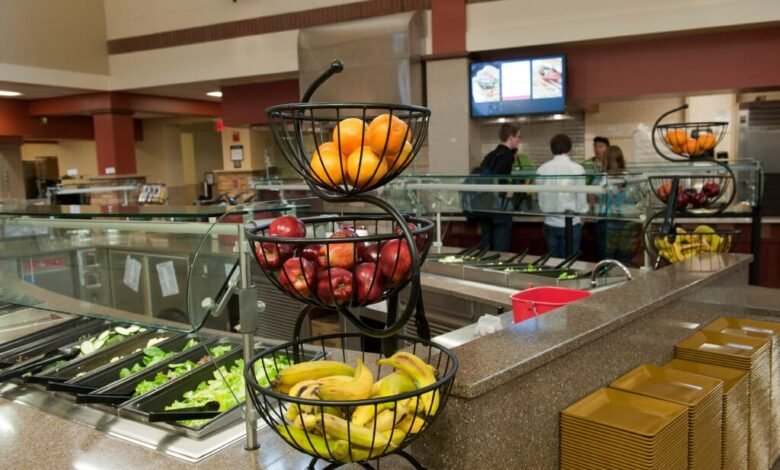College Cafeteria Advice From a Dietitian-Mom

Inside: Is your kid struggling with overwhelm, boredom, or burn-out in the college cafeteria? Here are real solutions from a campus dietitian, a mom, and been-there-done-that college students.
The transition to college brings a lot of adjustments–like a surprise case of homesickness, a killer chem class, or a roommate who brought along their pet snake.
Getting the hang of the college cafeteria can be challenging too.
For a kid used to familiar meals, around-the-clock kitchen access, and magically re-filled snack stashes, the first taste of leaving home can be….well, a bit sour.
As a mom to a college kid–and someone who remembers her own dining hall misadventures (hello, fro-yo for dinner!)–I know this well. So I rounded up some of the biggest obstacles new college students have with eating in the college cafeteria, plus practical solutions from a former campus dietitian, a college mom (me!), and current college students.
Obstacle #1: Your kid doesn’t have time to eat
High school days are predictable, but college schedules can feel tricky at first. Your kid’s schedule may change daily, and their class times might conflict with cafeteria hours. Add in clubs and sports, and it can be even tougher to navigate.
What to Try: Have your student sit down with their schedule and look for pockets of time–and think outside the box, says Gina Forster, MS, RDN, LDN, former Assistant Director of Nutrition for the Ohio State University Student Life Dining Services and now dietitian and owner of Nutrition Unmeasured. The best option may not always be sitting down in the dining hall, she says. For instance:
- Check to see if there are campus cafes, which may have different hours than the dining hall.
- Look for food options within campus fitness facilities (one of my kid’s favorite breakfast spots is the gym’s smoothie bar).
- Pack snacks in your bag to eat on breaks.
- Use mobile ordering during class breaks and pick up your meal after class.
Encourage your kid to schedule mealtimes in their paper or online calendar, just as they would classes and meetings. With all the distractions of a busy day, mealtimes are easy to ignore–or used as free time for hanging out with suite-mates or grabbing a nap.
But prioritizing nutrition right now really pays off. Balanced, filling meals will help them feel better physically (including bolstering their immune system against new germs and stressors) and emotionally, so they’re able to handle curveballs thrown at them that day.
Advice from a student: “Figure out places to eat that are close to your classes, not your dorm. If the dining halls aren’t open when you’re hungry, find walkable places to eat–because delivery fees are a killer.”

Obstacle #2: They don’t want to eat alone
Students’ schedules may differ from their friends and roommates. Or maybe they’re still working on making friends–and don’t WANT to eat with their new roommate! Freshmen may feel self-conscious about going into a cafeteria solo (and sitting alone) if they’re used to eating with their gang.
What to Try: Plenty of adults eat lunch solo every day, so reframing those awkward, uneasy feelings into signs of fledgling independence might help. The reality is, plenty of students are grabbing a quick bite on their own while watching videos on their phones or studying.
In fact, mealtime can be one of the few times your student gets to step away from constant interaction and recharge. It’s good practice for self-care and may quickly become a benefit in disguise.

But if that’s still not appealing, the dining hall might offer carry-out, which students can eat in their room or in an outdoor space. Here’s an example of a to-go meal.
Advice from a student: “I’d say about half the people in the dining hall are eating alone. You may even be sitting at the same table, but everyone is just doing their own thing.”

Obstacle #3: They’re in a pizza-pasta-French fries rut
The college cafeteria can be overwhelming at first. So once they’ve found a meal or two they like, your student may get into a pattern of eating those same items day in and day out. They may also fall back on familiar foods like pizza and French fries. That’s okay, but it can quickly lead to boredom–not to mention eating a smaller variety of food (which also means a smaller variety of nutrients).
You can’t manage your kids’ plates when they’re away from home, but arming them with some solid, and supportive nutrition advice can be helpful.
What to Try: Lean into BYO (Build Your Own) and mix it up, says Forster. “It’s the perfect opportunity to explore new flavors and textures,” she says. And she walks the walk: Forster says she’s eaten hundreds of meals on campus over the years. For example, bowls are a great vehicle for BYO. Try tofu, broccoli, quinoa and teriyaki one day. The next day, have it with brown rice, chicken, carrots, kale and a different sauce.
A BYO salad is also a healthy, satisfying meal. Here’s my personal formula for a meal salad:
- Greens: Mixed greens, kale, romaine, or baby spinach. Toss in some shredded cabbage for crunch and color.
- Protein: This is a key. Without protein, the salad won’t be satisfying. Try grilled chicken, hard-boiled egg, cooked lentils or beans like chickpeas, tuna, or even a chopped-up beef burger or veggie burger.
- Grain: Sprinkle on some quinoa, brown rice, or other grain from the stir-fry bar to make the salad more filling.
- Veggies: This is a great chance to get extra veggies. Use whatever’s on the salad bar or see if there are roasted veggies on the hot bar.
- Fruit: For some sweetness and color, add berries, chopped apple, dried fruit, or avocado.
- Nuts and Seeds: These provide great crunch, plus extra protein, fiber and healthy fats and are usually stocked at the salad bar.
Advice from a student: “The salad bar is your best friend!”

Obstacle #4: They’re burnt out on college cafeteria food
Campus dining has come a long way. There are so many more choices, styles, and cuisines these days. But your kid may still fizzle out on the food after a few months.
What to Try: Some campuses have cafes, restaurants, and even food trucks that accept meal plans. Ditto for convenience stores on campus. And many dorm rooms come equipped with a small refrigerator-freezer and microwave (or they may have access to a dorm floor kitchen). Check out my list of Healthy Foods for Dorms for staples they can stash in their rooms and even simple meals they can make using their microwave.

Advice from a student: “I have found that not going to the dining hall helps me eat well. Other restaurants around campus that allow meal swipes are more enjoyable for me. I even purchased groceries with microwavable healthy food options. If I do choose to go to the dining hall, I take my food to go.” (Here’s one of her take-out meals.)
Obstacle #5: They don’t feel good about how they’re eating
This is probably the first time your kid is navigating meals and snacks all on their own. They might gain weight in an all-you-can-eat environment–or lose weight if they’re struggling to find time to eat (or don’t love the food). Or maybe they’re living on pizza and fries and realize that they just don’t feel good.
In fact, this might be one of the first times they’ve put together the connection between food and lifestyle. They may start to see that a morning donut doesn’t have much staying power or that skipping lunch wrecks their afternoon energy level.
What to Try: If your kid is more likely to take advice from someone other than you, encourage them to look for a dietitian on campus (even though I’m a registered dietitian myself, my kids are more likely to listen to another “expert” too!).
Campus dietitians work in the dining services department or the wellness department, says Forster. Students may be able to meet with that person for free or at a low cost. A dietitian can work with a student to guide them and give them ideas for strategies and healthy meals to try. For example, here some of Forster’s favorite healthy go-tos at the campus cafeteria:
- Pasta: Top with marinara sauce and sauteed mushrooms, and add a piece of fruit or some steamed broccoli.
- Baked potato (white or sweet): Add toppings like steamed broccoli, shredded cheese, etc.
- Burgers: Beef, turkey, or veggie burger on a whole wheat bun with toppings.
- Grilled chicken sandwich: Add your favorite toppings like lettuce and tomato.
- Salads: Top it with grilled chicken or other protein, veggies, fruit, and seeds,
- Pizza: Pair it with a side salad, fruit, and yogurt.
- Sushi bowls or rolls: You’ll get fish, grains, and veggies in one meal.
Advice from a student: “Make a conscious effort to ensure you have greens on your plate. It’s super easy to make an easy choice and eat pizza every day, but it’s not worth it!”

Big thanks to the college students who provided advice and photos used in this post.
Source link
#College #Cafeteria #Advice #DietitianMom



